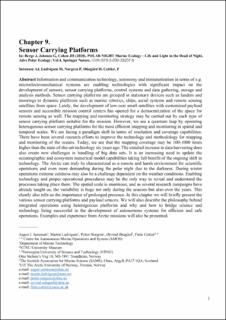| dc.description.abstract | Information and communication technology, autonomy, and miniaturization in terms of, for example, microelectromechanical systems are enabling technologies with significant impact on the development of sensors, sensor-carrying platforms, control systems, data gathering, storage, and analysis methods. Sensor-carrying platforms are grouped in stationary devices such as landers and moorings to dynamic platforms such as marine robotics, ships, aerial systems, and remote-sensing satellites from space. Lately, the development of low-cost small satellites with customized payload sensors and accessible mission control centers has opened for a democratization of the space for remote sensing as well. The mapping and monitoring strategy may be carried out by each type of sensor-carrying platform suitable for the mission. However, we see a quantum leap by operating heterogeneous sensor-carrying platforms for the most efficient mapping and monitoring in spatial and temporal scales. We are facing a paradigm shift in terms of resolution and coverage capabilities. There have been several research efforts to improve the technology and methodology for mapping and monitoring of the oceans. Today, we see that the mapping coverage may be 100–1000 times higher than the state-of-the-art technology 6 years ago. The entailed increase in data harvesting does also create new challenges in handling of big data sets. It is an increasing need to update the oceanographic and ecosystem numerical model capabilities, taking full benefit of the ongoing shift in technology. The Arctic can truly be characterized as a remote and harsh environment for scientific operations and even more demanding during the Polar Night due to the darkness. During winter operations, extreme coldness may also be a challenge dependent on the weather conditions. Enabling technology and proper operational procedures may be the only way to reveal and understand the processes taking place there. The spatial scale is enormous, and as several research campaigns have already taught us, the variability is huge not only during the seasons but also over the years. This clearly also tells us the importance of prolonged presence. In this chapter, we will briefly present the various sensor-carrying platforms and payload sensors. We will also describe the philosophy behind integrated operations using heterogenous platforms and why and how to bridge science and technology being successful in the development of autonomous systems for efficient and safe operations. Examples and experience from Arctic missions will also be presented. | en_US |
